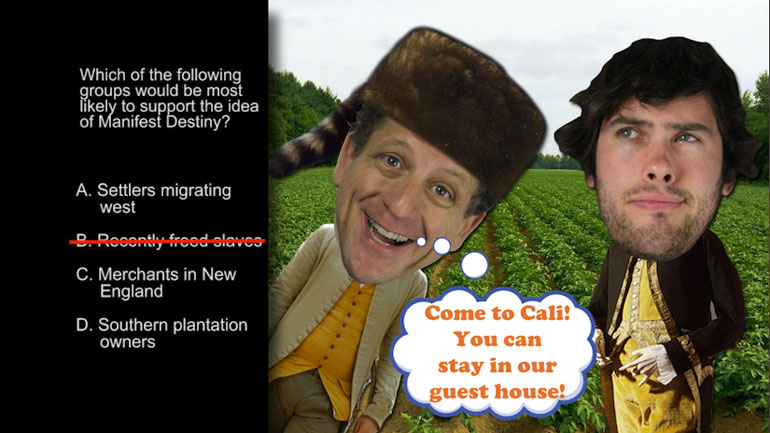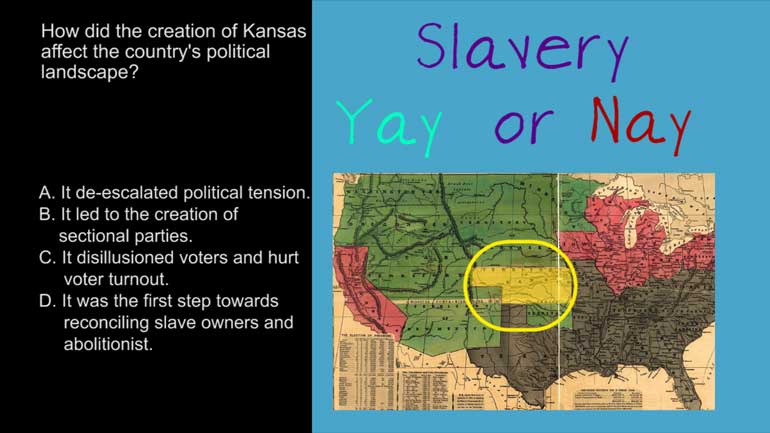ShmoopTube
Where Monty Python meets your 10th grade teacher.
Search Thousands of Shmoop Videos
Period 5: 1848-1877 Videos 18 videos
AP U.S. History 1.1 Period 5: 1848-1877. Which of the following groups would be most likely to support the idea of Manifest Destiny?
AP U.S. History 1.2 Period 5: 1848-1877. Before the Civil War, the idea of Manifest Destiny was most complicated by which of the following issues?
AP U.S. History: Religion and Reform in Antebellum America Drill 1, Problem 2. How did the creation of Kansas affect the country's political l...
AP U.S. History 2.3 Period 5: 1848-1877 198 Views
Share It!
Description:
AP U.S. History 2.3 Period 5: 1848-1877. Which of the following trends most severely undermines the intentions of the Thirteenth Amendment?
Transcript
- 00:00
[ musical flourish ]
- 00:04
And here's your Shmoop du jour, brought to you by stereotypes,
- 00:07
the wide array of audio equipment available at Radioshack.
- 00:10
Yeah, that kind.
- 00:12
All right, check out the picture.
Full Transcript
- 00:13
See the stereotypes there? Hmm?
- 00:15
Okay, well, in general, racial stereotyping,
- 00:18
like the minstrel show advertised above,
- 00:20
affected the national debate about
- 00:22
race by doing what?
- 00:24
And here are your potential answers.
- 00:26
[ mumbles ]
- 00:28
[ mumbling continues ]
- 00:30
Okay, well minstrel shows, which sometimes incorporated
- 00:33
blackface, were unfortunately all the rage in the early 19th century.
- 00:38
The show's simple language and crass humor
- 00:40
may have appealed to a wide swath of American society,
- 00:44
but they had a largely negative impact on
- 00:46
the national race conversation.
- 00:48
Let's see which answer best describes what happened.
- 00:51
Did racial stereotyping and minstrel shows
- 00:54
affect the national race debate
- 00:56
by A - portraying the atrocities of slavery
- 00:59
for New England audiences?
- 01:01
Hmm. Well, actually, minstrel songs and shows
- 01:03
ignored the realities of slavery,
- 01:05
favoring slapstick comedy and punchlines over anything
- 01:08
approaching realism.
- 01:10
Did minstrel shows impact the race conversation by
- 01:13
B - demonstrating how Whites and Blacks could coexist
- 01:17
peacefully?
- 01:19
Well, it was the opposite, in fact.
- 01:21
These shows made a point of demeaning black culture,
- 01:24
which reinforced the racial hierarchy and cemented the social status quo.
- 01:28
So that eliminates B and C.
- 01:30
Which means that these minstrel shows
- 01:31
affected the national race debate by
- 01:33
D - legitimizing racism by casting Blacks
- 01:37
as cheerful and lazy.
- 01:38
While minstrel shows claimed to show
- 01:40
authentic Black culture,
- 01:42
they actually relied on racist and pejorative stereotypes
- 01:45
that portrayed Blacks as, well,
- 01:47
cheerful, lazy slaves.
- 01:49
So the correct answer is D,
- 01:51
as in "damaging to everyone involved."
- 01:54
[ applause ]
Related Videos
AP U.S. History Exam 2.45. The journey shown on the map was an example of...what?
AP U.S. History Exam 2.26. This speech reinforced a shift in the focus of the war that Lincoln established by...what?
What did the Spanish messengers bring with them to North America? Hint: you probably wouldn't be thrilled to get this for your next birthday.
AP U.S. History Diagnostic 24. How did the United States choose containment over the National Security Council Report in Latin America?
AP U.S. History Exam 2.25. In writing the Gettysburg Address, Lincoln was still working to win over Northern voters who believed that...what?






















